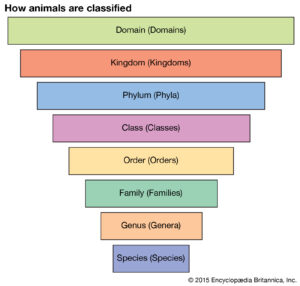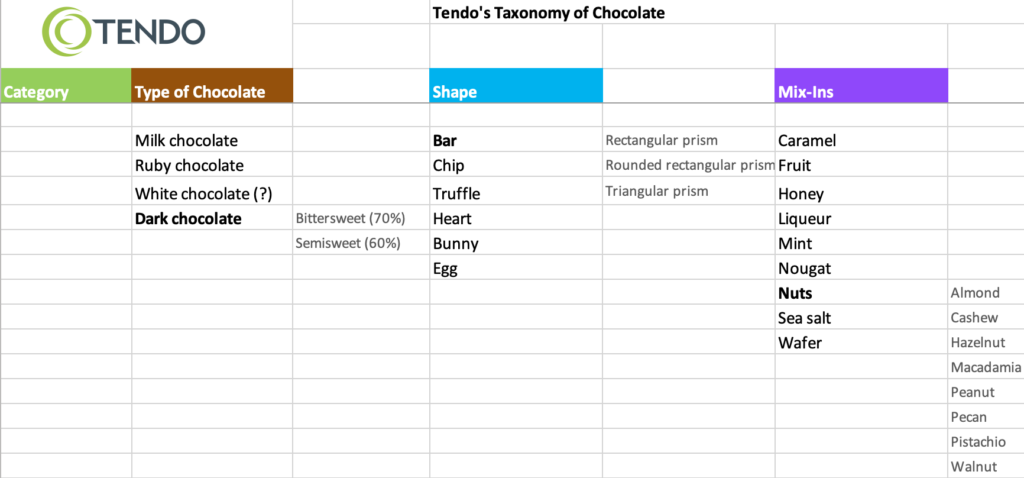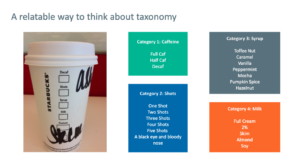If you’re developing a taxonomy to classify content and resources on your website, where should you begin?
A taxonomy is a way to group and organize digital content into different levels of categories so that people searching a website can more easily find what they’re looking for.
Taxonomies can be a challenge to create and maintain, but figuring out how to create a taxonomy is well worth the struggle. A well-planned taxonomy allows your content to be accurate, flexible, findable, and manageable, as well as enabling powerful content experience boosters like personalization.
To smooth out the bumps, here are six tips to keep in mind as you set up your taxonomy development process.
Taxonomy Development Tip #1: Avoid Unnecessary Hierarchies
Taxonomies began as a classification of the natural world. One of the earliest taxonomists, the Greek philosopher Aristotle, organized animals into over 500 types based on their habitat and physical characteristics.
Aristotle’s classification, while revolutionary for the time, contained only two main animal groups: vertebrates and invertebrates. These days, animals are classified by eight different categories: Domain, Kingdom, Phylum, Class, Order, Family, Genus, and Species.

These eight animal categories have a parent-child dependency. This means that they relate to one another: Your selection of a higher-level category will impact what other categories are available as you move down the list.
However, it’s a common pitfall to assume that all of your taxonomy’s categories will be dependent on each other. Think about it: when shopping online, would you want to click through eight different nested categories to find what you’re looking for? Probably not.
To avoid unnecessary hierarchies, think about the multiple ways your visitors can access your content and choose between content attributes. For example, let’s say you’re buying chocolate. You’ve got a lot of decisions to make, such as the type of chocolate, its shape, and which mix-ins to add.
However, none of those choices impact one another: choosing dark chocolate doesn’t preclude you from adding walnuts or buying truffles. In other words, the categories are independent.

In the example above, you’ll find three independent top-level categories. While each of these contains a tag with more specific dependencies (types of dark chocolate, bars, and nuts), the categories themselves are independent and unnested.
To establish your taxonomy’s categories, consider mapping your audience’s jobs to be done and task flows—their most important tasks and the different ways they can navigate your site to complete them. For example, someone who’s shopping for shirts can choose between different colors, sizes, and fabrics. These three categories are unrelated to each other, which allows for more sophisticated tagging and search filter functionality.
This mindset will help you move away from less navigable single-tree hierarchies like the animal kingdom, to multi-hierarchies that represent the relationships between your content more accurately.
And best of all, your customers will be able to find what they’re looking for in fewer clicks, which will lead to more conversions and lower bounce rates.
To learn more about how multi-tree hierarchies can facilitate user experience, dynamic content, and personalization, check out Tendo EVP and Managing Director Lindy Roux’s latest article on structured content.
Taxonomy Development Tip #2: Know Your Audience
Think about the ideal levels of categories for your taxonomy. They may be intuitive to you, but are they intuitive to your audience?
It’s important to remember who you’re creating your taxonomy for: the people who will be navigating your tags. Is your audience part of your organization, is your taxonomy public-facing, or is it a mixture of both?
Keeping your audience in mind as you decide how to create a taxonomy will allow you to determine the following:
- What level of detail is appropriate?
- Which tags will be most relevant to your audience?
- Which terms are most intuitive to your audience?
It’s easy to get caught up in internal jargon and shorthand. But people won’t navigate terms they don’t understand. Don’t lose sight of your audience’s background and familiarity levels, and make sure your taxonomy can help them find what they’re looking for.
Taxonomy Development Tip #3: Align Your Teams
As important as they are, your external audience isn’t the only audience to consider.
For a well-rounded taxonomy, set up interviews with team members to start pinpointing the categories and tags that will be needed. This step is crucial for both internal and external taxonomy development, since your teams will be using and interacting with the taxonomy on their end.
“People who tag, classify, or index with the taxonomy are another set of users who need to be consulted in the process. User input can inform the design of the taxonomy, such as how many hierarchies or facets it should have, how many levels deep it should be, and what some of the most important terms are to include.”
— Heather Hedden, author of The Accidental Taxonomist
Even after your taxonomy is launched, it’s a good idea to continue to keep your departments in the loop. Buyers interact with multiple departments across the buyer journey, and their experience should be consistent. Controlled vocabularies can ensure that your sales, marketing, and support teams are all speaking with the same voice.
Taxonomy Development Tip #4: Make Your Taxonomy Relatable
Taxonomies may not be for everyone, and that’s OK. But it is important to make your taxonomy engaging and understandable for those in your organization who will be impacted by it.
When explaining taxonomy to your teams, you can incorporate relatable concepts to bring your taxonomies to life. At Tendo, we like to frame taxonomy in terms of your Starbucks order.

Framing your taxonomy in real-world examples will bring it down to earth, allowing team members to understand its purpose. This will result in higher levels of engagement and more meaningful input into your taxonomy’s creation and evolution.
To see this principle in action, check out our blog post Good Deals, Good Taxonomy, in which we ground taxonomy principles and best practices in a favorite Tendo pastime: online shoe shopping.
Taxonomy Development Tip #5: Showcase Your Taxonomy’s Value
While fostering cross-departmental understanding of your taxonomy is important, appreciation for its value is even more essential.
Taxonomies are like skeletons—essential to a body’s structure, but invisible to the eye.
That’s why taxonomies often fly under the radar: A well-functioning taxonomy doesn’t call attention to itself. Therefore, it’s all the more important to highlight your taxonomy initiatives and showcase the value they provide.
Get other departments and in-house clients on board with future taxonomy initiatives by explaining the benefits of a well-functioning taxonomy:
- Consistent, controlled vocabularies
- Search optimization
- Data segmentation
- Content findability
- Intuitive user experience

Highlight your taxonomy’s ROI to create buzz and excitement for its next iteration. In addition, you can use these strategies to help bring external stakeholders on board and legitimize budget and resources for continued taxonomic efforts.
Celebrating your taxonomy brings visibility to the value you’re providing, and demonstrates the link between healthy taxonomies and healthy businesses.
Taxonomy Development Tip #6: Plan for the Future
Now that you’ve proven your taxonomy’s ongoing value to your teams, you can start planning its long-term growth.
The world is constantly evolving, so your taxonomy should be too. To stay relevant, taxonomies need to be maintained and updated regularly.
Taxonomy governance is the practice of overseeing taxonomy development so that it stays consistent over time. Taxonomy governance will enable you to plan for:
- Who is responsible for maintaining your taxonomy
- What tags should be retired or introduced
- When your taxonomy should be audited for future updates
- Where new tags and categories will fit into your site hierarchy
- How processes such as change requests are handled
Governing your taxonomy will ensure that it can grow to support changes in your organization’s structure or offerings. So, after launching your taxonomy, make sure that a long-term plan is in place for future updates and iterations.
Closing Thoughts on Taxonomy Development
Flexible taxonomies are essential to reaping the full benefits of powerful digital experience platforms (DXPs) and content management systems (CMSs). The world is shifting to be even more reliant on digital-first experiences. With the right taxonomy in place, you can help your audience find and navigate your digital content more easily.
Still Not Sure How to Create a Taxonomy for Your Content?
Tendo offers taxonomy services such as taxonomy creation, analysis, and optimization to support an intuitive user experience. To get started, contact our team of content strategists and UX experts today.
First published May 5, 2021









